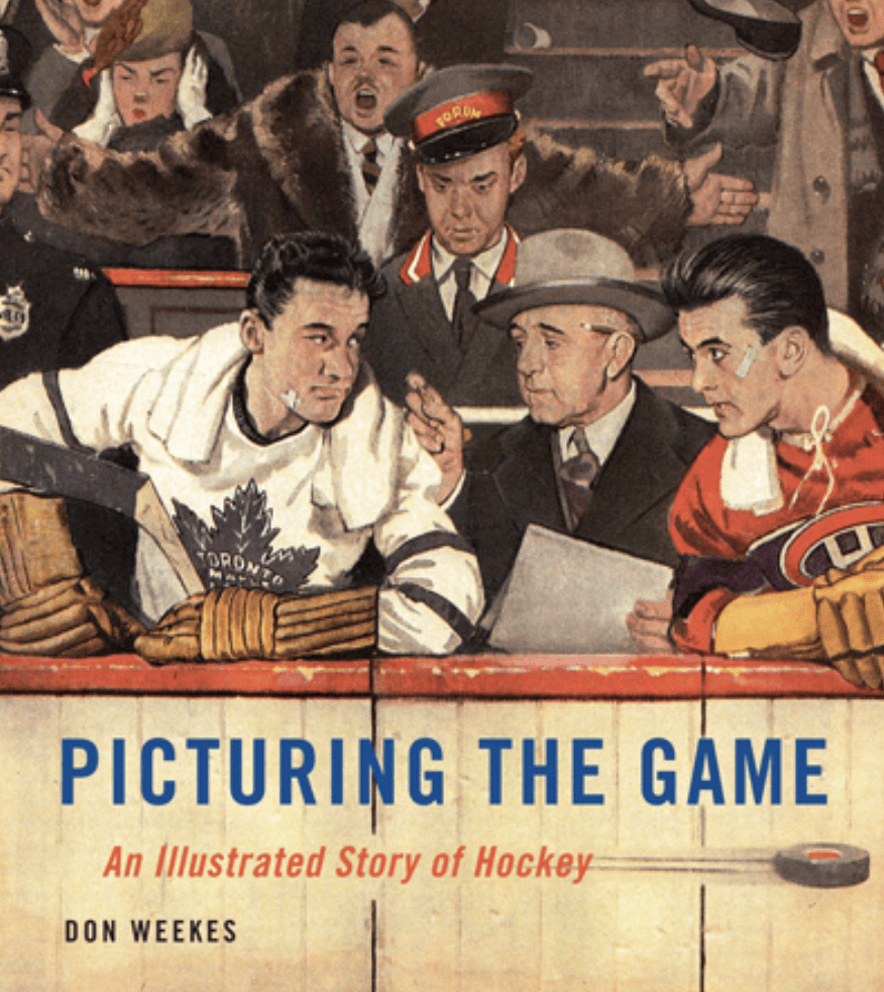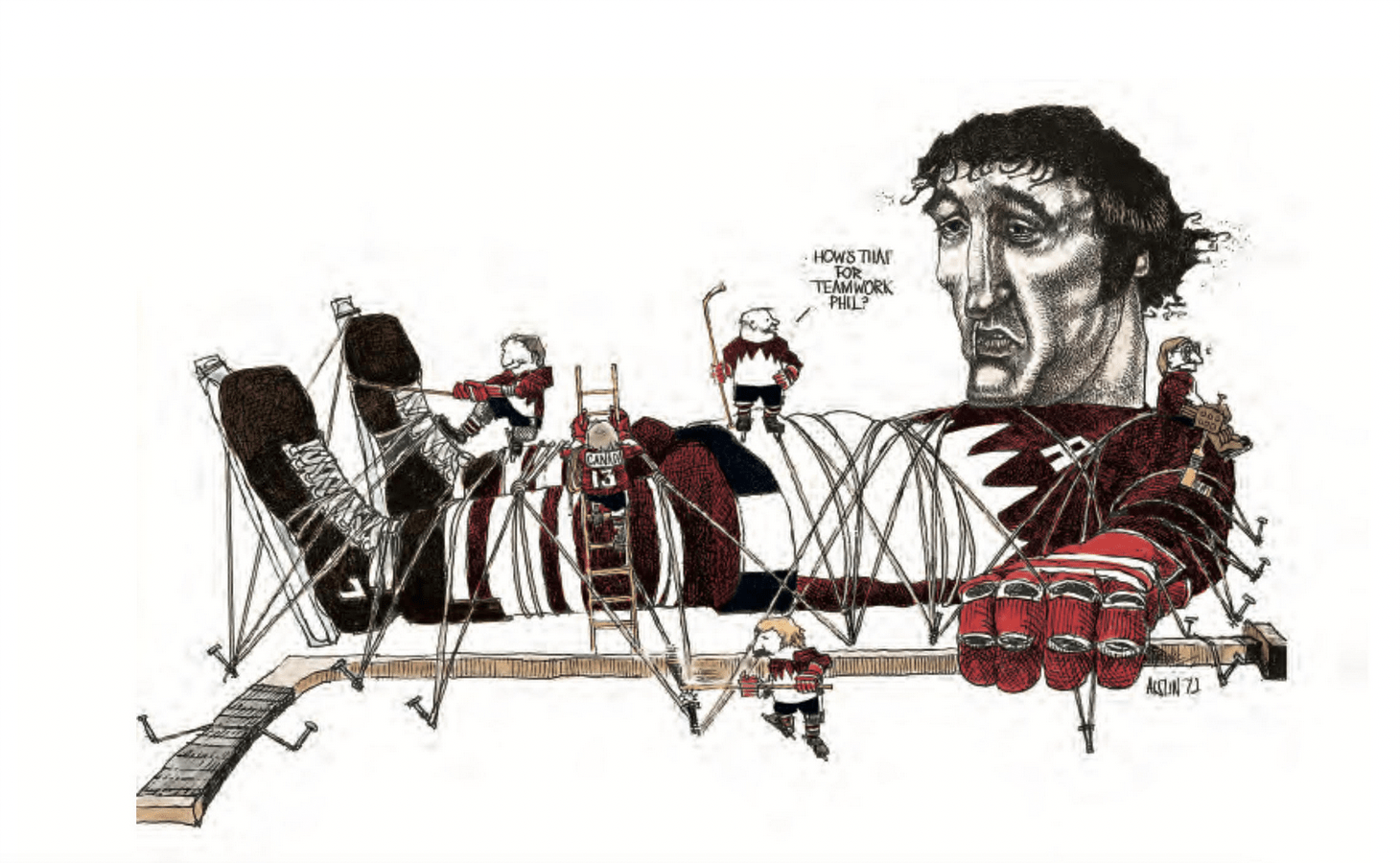‘Picturing the Game’: The Picture-Perfect Hockey Book

Picturing the Game: An Illustrated Story of Hockey
McGill-Queens University Press/October 2023
Reviewed by Paul Deegan
December 3, 2023
When Policy magazine asked me to review Picturing the Game: An Illustrated History of Hockey by Don Weekes, I thought to myself, “Piece of cake; I can breeze through a picture book and knock off a review in under an hour.”
Like Evan and Bruce Dowbiggin’s Inexact Science and Gary J. Smith’s Ice War Diplomat, Weekes puts the puck in the net — top shelf at that — with this effort.
As I started to flip through the first few pages of the PDF of the book, my ‘piece of cake’ thesis seemed spot on. However, as I scrolled to the end, I quickly realized that this 400-page tome was going to take even this speedy reader into at least triple overtime.
Weekes presents a compelling case for what a crucial role illustrators and sports cartoonists have played in capturing and promoting Canada’s national pastime.
When most of us think of a visual image of hockey, we think of that iconic black-and-white photograph of Bobby Orr frozen in flight after scoring the game-winning goal in the 1970 Stanley Cup final. Despite amazing advances in photographic technologies, there has never been a more perfect image of the game since that one.
In the early 1900s, there were no 35mm cameras, let alone the long lens digital beasts of today. The beginnings of the game were captured by the Montreal Daily Star – the city’s main anglo newspaper at the time. The Star contained lengthy written reports about hockey games, which were soon supplemented by illustrations and cartoons.
Early illustrators and cartoonists were among the first to bring the violence of hockey into public consciousness. Interestingly, in those early days, sports were considered entertainment and reports of early Stanley Cup finals never even made it to a newspaper’s front page.
This book is a trip to the Hockey Hall of Fame, the National Gallery of Canada, and the Toronto Reference Library all without having to leave the comfort of your couch on a snowy winter morning.
Weekes rightly observes that ‘although the art of cartooning is complex, the result has to be simple.’ Growing up in Montreal, I became a big fan of the Montreal Gazette’s Terry Mosher, better known as Aislin, who explained his craft to Weekes this way, “It’s not predictable…That’s the beautiful thing about the human brain. We have no idea how it works. I think of it as being a pinball machine up there and these balls bounce around and they drop in different holes in various combinations. Then, boom! You come up with something.” Aislin comes up with something brilliant time after time.
Weekes argues that if our best editorial cartoonists can satirize greed, social injustice, and political idiocy on editorial pages, how hard could heckling hockey’s cast of characters possibly be, arguing that Canada’s game – like our politicians – offers more than its share of great material.
Photography eventually emerged as the primary visual medium in hockey. In the early days, photo editors attempted to explain to readers what they were looking at with inserted arrows and dotted lines, and even inserted player names into the photos. By Toronto’s victory over Montreal in the 1947 Stanley Cup finals, it was evident that illustration had taken a backseat to photography in newspapers. Sports cartoonists, however, continued to flourish, and the matches against the Soviets in the 1972 Summit Series provided particularly great Cold War material for them and belly laughs for the rest of us, as Aislin memorialized in his own picture book, Montreal to Moscow.

According to Weekes, Aislin/Mosher filed cartoons for Canadian-site games with the Soviets from Toe Blake’s Tavern, but he jetted off to Moscow to illustrate Jack Ludwig’s book, Hockey Night in Moscow. In addition to the tools of his craft, Mosher showed up at four the Moscow games with photo equipment and bogus photographer credentials to conceal his occupation as a political/sports cartoonist. One of his great cartoons was of Phil Esposito, in which Espo was re-cast as Jonathan Swift’s Gulliver, roped and bound by his teammates (above). Aislin recalls how his ‘victim’ threatened to beat him up. “He told me, ‘I don’t want that cartoon to be printed.’ I told him, ‘Too bad. It already has.’”
Picturing the Game: An Illustrated Story of Hockey has wide appeal. Not only is it the perfect book for the hockey fan in your life, it tells the social story of Canada over the past 125 years from an interesting perspective, and its vast compilation of illustrations and cartoons is truly a treasure-trove of Canadiana. This book is a trip to the Hockey Hall of Fame, the National Gallery of Canada, and the Toronto Reference Library all without having to leave the comfort of your couch on a snowy winter morning. It’s a significant piece of scholarship worthy of a Ph.D, yet it’s highly entertaining and very readable. It’s also a reminder that no one does a hockey cartoon better than the great Terry Mosher – a.k.a. Aislin.
In short, Picturing the Game is a hat trick: Great to look at, a great read and a wonderful souvenir for fans of the national game.
Paul Deegan is a contributing writer to Policy Magazine and a Montreal Canadiens fan.
